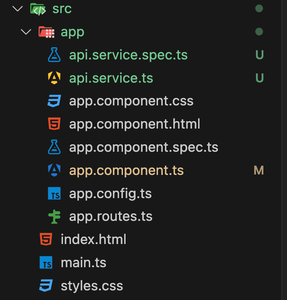|
Testing is an important part of software development, ensuring that your application functions correctly and meets the requirements. Angular provides a powerful module for testing HTTP requests called HttpClientTestingModule. This article will guide you through the process of setting up and using HttpClientTestingModule to test HTTP requests in your Angular application.
Steps to Test with HttpClientTestingModuleStep 1: Initialising the projectLet’s create an angular project, and navigate into it with the below commands:
ng new angular-test
cd angular-test Step 2: Create an API serviceNow, create an API service in the angular application using the below command, to write the code to fetch the data using a public API.
ng generate service api We will write the logic to fetch data from a public API, like `https://jsonplaceholder.typicode.com` to fetch users data.
Project structure Folder Structure Dependencies"dependencies": {
"@angular/animations": "^18.0.0",
"@angular/common": "^18.0.0",
"@angular/compiler": "^18.0.0",
"@angular/core": "^18.0.0",
"@angular/forms": "^18.0.0",
"@angular/platform-browser": "^18.0.0",
"@angular/platform-browser-dynamic": "^18.0.0",
"@angular/router": "^18.0.0",
"rxjs": "~7.8.0",
"tslib": "^2.3.0",
"zone.js": "~0.14.3"
}Example: To demonstrate testing angular HttpClient Testing Moudle.
JavaScript
// api.service.spec.ts
import { TestBed, inject } from '@angular/core/testing';
import {
HttpClientTestingModule,
HttpTestingController
} from '@angular/common/http/testing';
import { UserService } from './api.service';
import { HttpEvent, HttpEventType } from '@angular/common/http';
describe('ApiService', () => {
let service: UserService;
beforeEach(() => {
TestBed.configureTestingModule({
imports: [HttpClientTestingModule],
providers: [UserService]
});
service = TestBed.inject(UserService);
});
it(
'should get users',
inject(
[HttpTestingController, UserService],
(httpMock: HttpTestingController, userService: UserService) => {
const mockUsers = [
{ name: 'Alice', website: 'example.com' },
{ name: 'Bob', website: 'example.org' }
];
userService.getData().subscribe((event: HttpEvent<any>) => {
switch (event.type) {
case HttpEventType.Response:
expect(event.body).toEqual(mockUsers);
}
});
const mockReq = httpMock.expectOne(userService.url);
expect(mockReq.cancelled).toBeFalsy();
expect(mockReq.request.responseType).toEqual('json');
mockReq.flush(mockUsers);
httpMock.verify();
}
)
);
});
//app.component.ts
import { Component } from '@angular/core';
import { RouterOutlet } from '@angular/router';
import { UserService } from './api.service';
import { HttpEvent, HttpEventType } from '@angular/common/http';
@Component({
selector: 'app-root',
standalone: true,
imports: [RouterOutlet],
templateUrl: './app.component.html',
styleUrl: './app.component.css'
})
export class AppComponent {
title = 'angular-test-2';
users: any = [];
constructor(private userService: UserService) { }
ngOnInit() {
this.fetchUsers();
}
fetchUsers() {
this.userService.getData().subscribe((event: HttpEvent<any>) => {
if (event.type === HttpEventType.Response) {
this.users = event.body;
}
});
}
}
// api.service.ts
import { Injectable } from '@angular/core';
import { HttpClient, HttpRequest } from '@angular/common/http';
@Injectable({
providedIn: 'root'
})
export class UserService {
url = 'https://jsonplaceholder.typicode.com/users';
constructor(private http: HttpClient) { }
getData() {
const req = new HttpRequest('GET', this.url, {
reportProgress: true
});
return this.http.request(req);
}
}
Run the test using the below command:ng test --browsers=ChromeHeadless --include="src/app/api.service.spec.ts" Output Testing with the Angular HttpClientTestingModule
|


